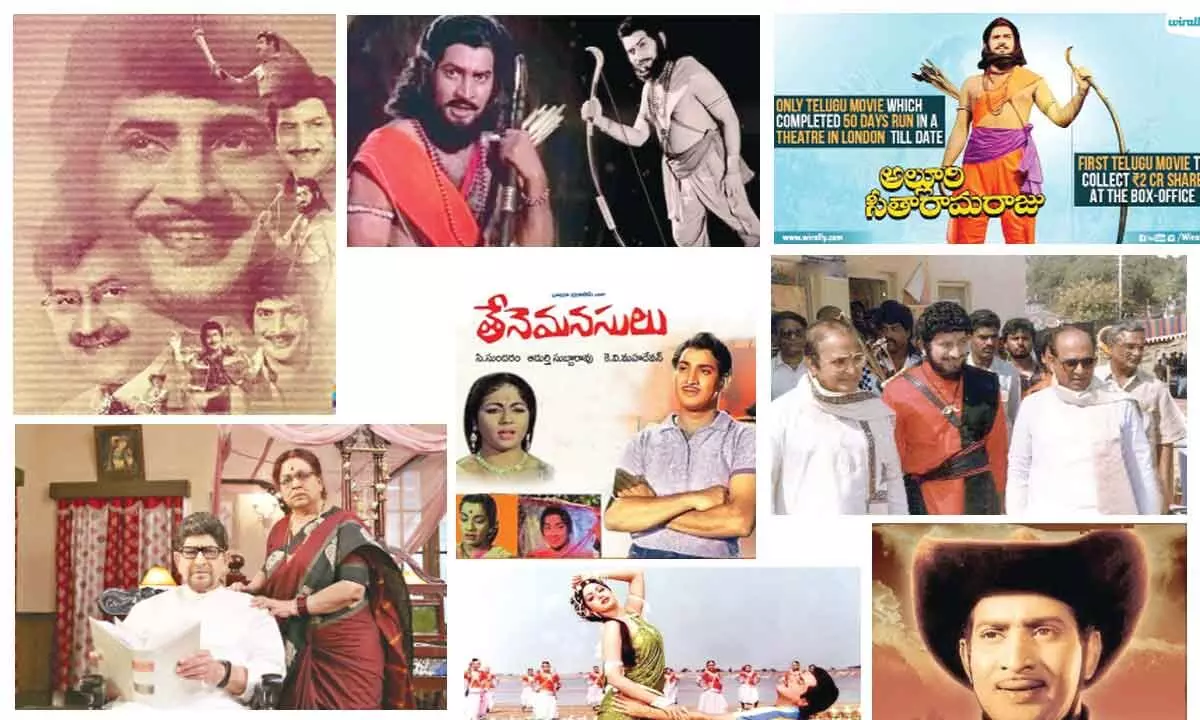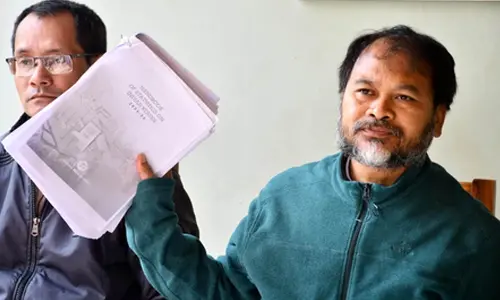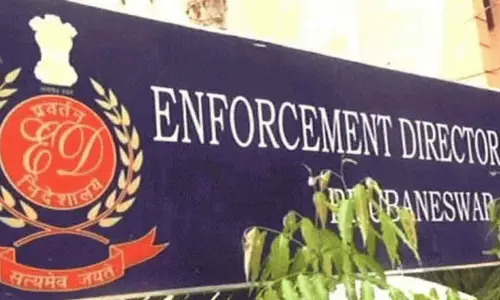'Burripalem Bullodu' with a matchless charisma

- Between 1960s and 70s, Krishna, with 10 film releases every year which went on for three decades of his career locked horns with his seniors NTR and ANR and contemporaries Sobhan Babu and Krishnam Raju in the box-office battles.
- He paired with Vijayanirmala in 48 films who later became his wife, apart from Jaya Prada who was his lady love in 47 movies, a record of sorts in Indian cinema
The decades between 1960-90 saw tectonic shifts in how Telugu film industry evolved and emerged as a top commercial film factory of Indian movie making. As early as March 1965, when the black and white era films had just stabilised in India, in a breakthrough of sorts, a movie – Thene Manasulu – comprising a set of fresh faces (selected from thousands of aspirants who applied for the main roles) was released. This was the first social theme-based film released in Eastman colour.
It was also the smashing launch for Ghattamaneni Siva Rama Krishna Murthy, known popularly as Krishna at the age of 21. The success of this film kept Krishna, who passed away at the age of 79 on Tuesday morning in the top rungs of Telugu filmdom for a long, long time. A point to note is that with the same title, he acted in a Telugu remake of the Rajesh Khanna hit 'Souten' which was released in 1987. In all, he acted in 350+ films and during the final decade of his career which ended with his film 'Sri Sri' released in 2016, he was seen appearing in Tamil films too in cameo roles.
'Thene Manasulu', remade as 'Doli' in 1969, was counted as one of the 17 continuous hits of Rajesh Khanna between 1969-71, a contemporary of sorts for Superstar Krishna (see Box: Many of Krishna's films were remade into all-India hits). If the former's notable achievement is considered unmatched in Indian cinema even after its 100+ years of existence, the latter too had notched up his own sets of records. From his debut to the 1990s, a study reveals that 'Natasekhara' Krishna has had an average of 10 releases a year in Telugu cinema. This, when, he faced stiff competition from the seniors N T Rama Rao and A Nageswara Rao, contemporaries Sobhan Babu and Krishnam Raju in the 1960s and 1970s. His ability to bounce back after setbacks was amply demonstrated when he faced a series of 14 flop films between 1974-76, yet made a triumphant comeback with 'Padi Pantalu' in 1976.
He managed to hold his ground in the 1980s when the post- Independence generation of heroes represented by Kamal Haasan, Rajinikanth, Balakrishna, Chiranjeevi, Nagarjuna, Venkatesh were heartthrobs all over India. The most interesting point was he had not only co-acted as one among the leads along all his erstwhile contemporaries but also shared screen space with the icons of the 1980s till his final years of acting phase.
Jaya Prada, his heroine and also seen pairing with the other lot of top stars of that era was seen along with him in 47 films, a record unmatched in Indian cinema. Also, it looked he had no fear of over-exposure unlike his later day successors, who have stuck to one film in two years and more to ensure better and bigger returns at the box office, an elusive prospect many a times.
Hence, he not only retained his fan base, but also broke new records as a Superstar, producer and director with the first spy film (Goodachari 116) cowboy actioner (Mosagallaku Mosagadu), first socio-mythological (Alluri Seetarama Raju) and the first 70mm film (Simhasanam) shot simultaneously in Hindi and Telugu, first DTS film (Telugu Veera Levara) and many more. Quite interestingly, it was his home production 'Vamsi' released in 2000 with Mahesh Babu and Namrata Shirodkar as the lead pair which resulted in a romantic relationship between the two, leading to their marriage a few years later.
In the 1980s, Krishna's foray into politics, like the veteran NTR happened in 1989 when he was elected as MP for Eluru on a Congress ticket, heeding the invitation of Rajiv Gandhi. As a beginning of the star wars extending back and forth from cinema to politics , film industry watchers recall how his 1986 film ' Naa Pilupe Prabhanjanam', a sharp satire on the Telugu Desam founder turned out to be a hit. Later, his film 'Sahasame Naa Oopiri' released in 1989 was a satire-cum-crime movie which focused uncomfortably on the death of the Vijayawada Kapu leader, Vangaveeti Mohana Ranga. The film not only managed to make an impact but ran for a decent period in theatres, with the Rayalaseema region giving the film a thumbs up, an area where Krishna's films had only done average business always. That was also the time a few more films were released on the political rivalry between the two, with Krishna using the celluloid medium to telling effect. He retired from active politics in 2012, and after his last film released six years ago, had maintained a low profile till his death. He was definitely a titan, probably the last of the leading heroes in southern cinema born in the 1940s to make his final bow.
Many of Krishna's films were remade into all-India hits
A selective study of 15 remakes of hit films of Krishna between the active years of his career from 1967-1996 reveal interesting facts. The first film of his which was remade into Hindi – Farz (1967) - was his third one in Telugu – Gudachari 116, released in 1966 in which his heroine was the then popular face Jayalalitha, who had already acted in 20 southern films by then after a debut a year earlier. For the 25-year-old Hindi film hero Jeetendra, it was an image-breaker from his chocolate boy one as he made a good impact with this spy thriller, which was his fifth release. Over the next two decades, Jeetendra went on to act in 10 remakes, the maximum number of Krishna's hits starring him.
Krishna's first release 'Thene Manasulu' in 1965, as mentioned elsewhere, managed a remake release only four years later as 'Doli', a part of the 17 successful hits of Rajesh Khanna. Yet, from 1967-1996, none of his major releases in Telugu were left untapped by either Hindi or Tamil film banners. His own banner Padmalaya Productions too chipped in with many movies in this phase. During this period, there were simultaneous productions launched in Telugu and Hindi which went on to make a positive impact in both the languages.
One such 1986 release 'Simhasanam' had the in-demand Mandakini as one of the heroines which enabled the appeal of Hindi film audiences better, even as his heroine Jaya Prada, Sridevi and Radha effectively kept the presence of southern film heroines at a high level. The Superstar also kept churning out remakes from Tamil and Hindi in Telugu to sustain his popularity comprehensively.














